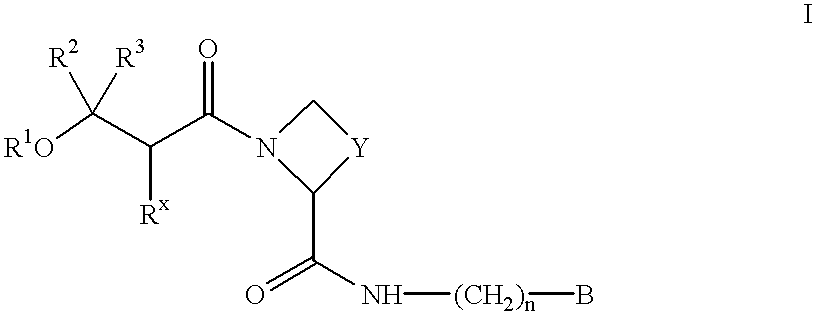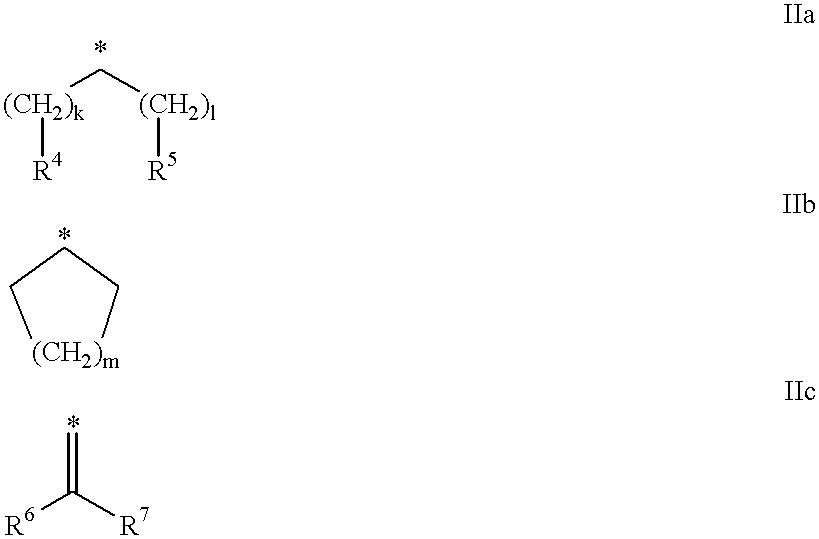Amino acid derivatives and their use as thrombin inhibitors
a technology of thrombosis inhibitors and amino acid derivatives, which is applied in the direction of biocide, drug composition, extracellular fluid disorder, etc., can solve the problems of thrombosis and other diseases
- Summary
- Abstract
- Description
- Claims
- Application Information
AI Technical Summary
Benefits of technology
Problems solved by technology
Method used
Image
Examples
example a
H-Aze-Pab(Z)
(i) Boc-Aze-OH
Di-tert-butyl dicarbonate (13.75 g; 63 mmol) was added with stirring at room temperature to a mixture of L-azetidine-2-carboxylic acid (H-Aze-OH; 5.777 g; 57 mmol) and Na.sub.2 CO.sub.3 (6.04 g; 57 mmol) in water (50 mL) and THF (100 mL). After 60 h the THF was removed in vacuo and the mixture was diluted with water and then acidified with 2M KHSO.sub.4. Extraction with CH.sub.2 Cl.sub.2 followed by drying (MgSO.sub.4) and evaporation of the solvent gave a residue which was crystallized from CH.sub.2 Cl.sub.2 :hexane to give 10.87 g (95%) of colourless crystals.
.sup.1 H NMR (300 MHz; CDCl.sub.3): .delta. 4.85-4.7 (br s, 1H), 4.0-3.75 (m, 2H), 2.65-2.35 (m, 2H), 1.4 (s, 9H).
(ii) Boc-Aze-Pab(Z)
At room temperature, EDC (13.5 g; 70 mmol) was added to a mixture of Boc-Aze-OH (10.87 g; 54 mmol; from step (i) above), H-Pab(Z).times.HCl (18.31 g; 57 mmol; prepared according to the method described in International Patent Application WO 94 / 29336) and DMAP (9.9 g; 81...
example b
H-Pic-Pab(Z).times.2 HCl
(i) Boc-Pic-OH
Prepared according to M.Bodanszky and A.Bodanszky ("The Practice of Peptide Synthesis", Springer-Verlag (1984)) using THF instead of dioxan as solvent.
.sup.1 H NMR (300 MHz; CDCl.sub.3): .delta. 5.0-4.8 (br d, 1H), 4.0 (br s, 1H), 3.0 (br s, 1H), 2.20 (d, 1H), 1.65 (m, 2H), 1.5-1.3 (s+m, 13H)
(ii) Boc-Pic-Pab(Z)
Boc-Pic-OH (2.02 g; 8.8 mmol; from step (i) above), H-Pab(Z).times.1 HCl (2.36 g; 7.4 mmol; prepared according to the method described in International Patent Application WO 94 / 29336) and 3.9 g (32 mmol) DMAP were dissolved in CH.sub.2 Cl.sub.2 (40 mL). The mixture was cooled to 0.degree. C. and 1.99 g (10.4 mmol) of EDC was added. The reaction mixture was stirred in room temperature for 3 days. The mixture was poured into a 0.2 M KHSO.sub.4 solution and extracted twice with CH.sub.2 Cl.sub.2. The organic layer was dried (Na.sub.2 SO.sub.4) and evaporated. The crude product was flash chromatographed on silica gel using EtOAc:toluene 7:3 as...
example c
H-Aze-Pia(Z).times.2 HCl
(i) Boc-Aze-Pig(Z)
At room temperature, Boc-Aze-OH (1.03 g; 5.12 mmol; from Example A(i) above) was dissolved in acetonitrile (50 mL) and DMAP (1.57 g, 12.8 mmol) was added to the resultant solution. H-Pig(Z).times.2 HCl (1.86 g, 5.12 mmol; prepared according to the method described in International Patent Application WO 94 / 29336) in DMF (20 mL) and EDC (1.47 g; 7.68 mmol) was then added and the reaction mixture was stirred at room temperature for 20 h. The reaction mixture was subsequently concentrated, diluted with CH.sub.2 Cl.sub.2 (100 mL) and was washed with H.sub.2 O (2.times.30 mL). The organic layer was dried (MgSO.sub.4) and evaporated. The crude product (3.77 g) was purified by flash chromatography on a silica gel column eluted with CH.sub.2 Cl.sub.2 :MeOH (95:5) to give 1.24 g (51%) of the title compound.
.sup.1 H NMR (400 MHz; CDCl.sub.3): .delta. 7.27-7.43 (m, 5 H), 5.12 (s, 2 H), 4.60-4.67 (t, 1 H), 4.16-4.26 (d, 2 H), 3.86-3.95 (m, 1 H), 3.74-3.8...
PUM
| Property | Measurement | Unit |
|---|---|---|
| temperature | aaaaa | aaaaa |
| temperature | aaaaa | aaaaa |
| clotting time | aaaaa | aaaaa |
Abstract
Description
Claims
Application Information
 Login to View More
Login to View More - R&D
- Intellectual Property
- Life Sciences
- Materials
- Tech Scout
- Unparalleled Data Quality
- Higher Quality Content
- 60% Fewer Hallucinations
Browse by: Latest US Patents, China's latest patents, Technical Efficacy Thesaurus, Application Domain, Technology Topic, Popular Technical Reports.
© 2025 PatSnap. All rights reserved.Legal|Privacy policy|Modern Slavery Act Transparency Statement|Sitemap|About US| Contact US: help@patsnap.com



